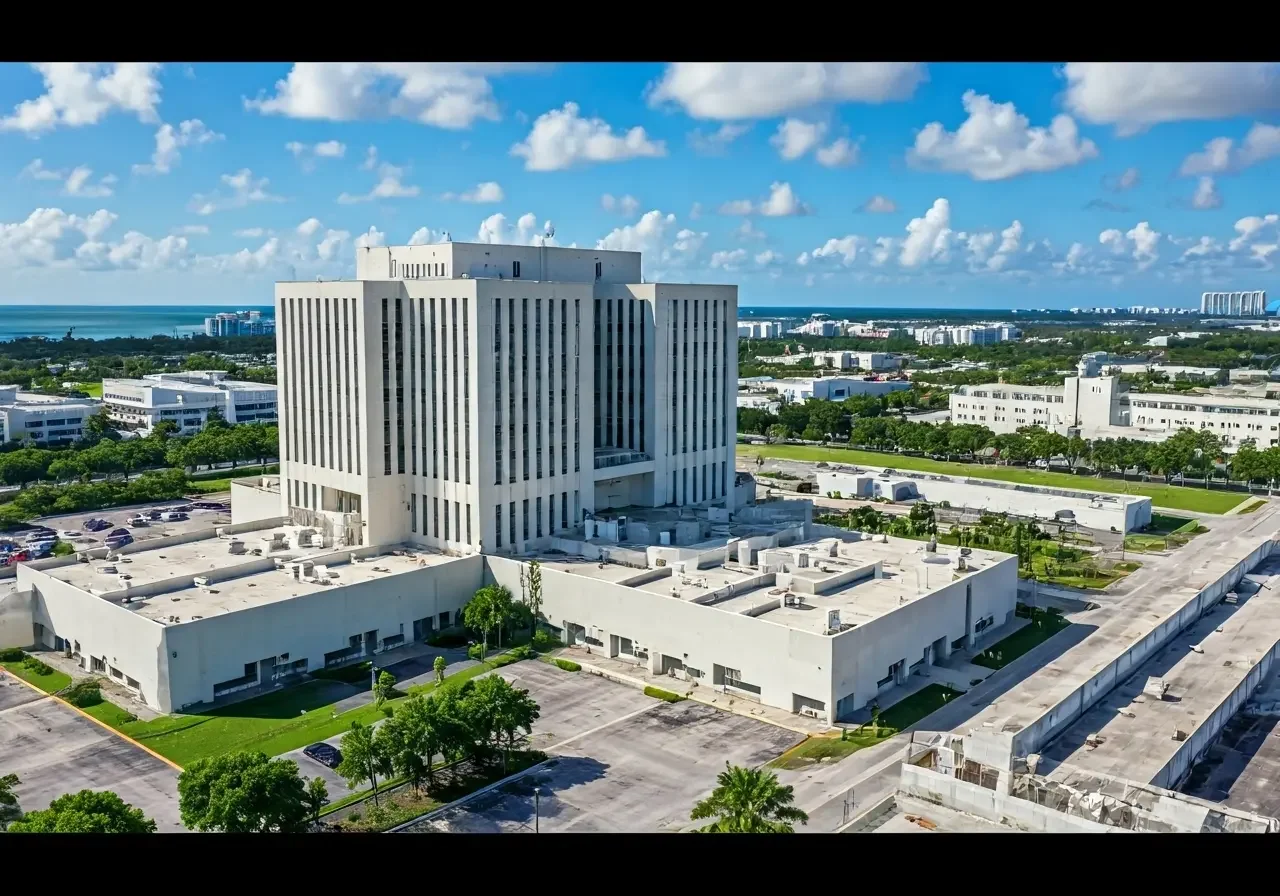15 Frequently Asked Questions About Federal Detention Center Miami
Navigating the intricacies of the Federal Detention Center Miami can be daunting for many. Whether you're seeking information for personal understanding or professional purposes, having clear and concise answers can be incredibly helpful. This blog addresses some of the most frequently asked questions, providing clarity and insight into this facility.
1. Overview of Federal Detention Center Miami
Located in the heart of Florida’s vibrant city, this detention center plays a crucial role in housing individuals awaiting trial or serving short sentences. Its importance within the federal justice system is significant. The facility is deliberately positioned to facilitate the easy transfer of detainees to local federal courts, thereby streamlining judicial processes.
Known for its robust infrastructure, the Federal Detention Center Miami is equipped to handle a wide array of cases. The architecture is designed to optimize security while maintaining humane conditions for its inmates. This unique balance of safety and comfort is critical in maintaining the center’s operational efficiency.
2. Who Is Held at This Facility?
The center primarily accommodates individuals who are awaiting federal court proceedings or serving brief federal sentences. It serves a temporary holding role within the broader correctional system. This distinction is vital because it underscores the transitional nature of the center's inmate population.
The facility also occasionally houses individuals from other jurisdictions awaiting transfer to other federal institutions. This ability to accommodate such a diverse group allows the facility to play a pivotal role in the federal corrections system. The complex status of many detainees can require coordinated efforts across multiple legal frameworks.
3. What Are Visiting Hours?
Visitation times are specifically scheduled to ensure orderly and safe visits. Visitors are encouraged to arrange their visits beforehand to guarantee they adhere to the center’s rules and regulations. Typically, visitation is allowed throughout the week, but scheduling may vary depending on the detainee's legal status or security level.
It's crucial for visitors to be aware of the strict security protocols in place. All visitors must undergo a security screening and comply with specific dress codes. These measures are designed to protect both the visitors and residents, ensuring that interactions are safe and beneficial for all involved.
4. How Can Inmates Be Contacted?
Communication with inmates is possible through selected and monitored phone calls, as well as mail services, ensuring both security and the maintenance of connections with loved ones. These methods are pivotal to preserving familial and legal relationships during their time in custody.
The facility has implemented systems to monitor all correspondence to prevent contraband or unwanted communication. Such stringent measures are sometimes seen as restrictive but are necessary to maintain a secure environment within the center.
5. What Programs Are Available for Inmates?
The center offers a range of educational and rehabilitation programs aimed at supporting inmates’ development during their stay, which can include classes and skill-building workshops. Such programs are vital, as studies show rehabilitation helps reduce the likelihood of reoffending.
Inmates have access to various resources that enable them to complete education credits, develop vocational skills, or engage in therapeutic support. These initiatives aim to prepare inmates for a productive life post-detention, marking the facility's commitment to holistic correctional solutions.
6. Security Measures and Protocols
Security in the facility is paramount, with stringent measures in place to ensure the safety of both staff and inmates, including controlled access, surveillance, and regular inspections. These systems are continuously reviewed and updated to respond to new safety challenges.
The center integrates technology, such as biometric scanning and comprehensive monitoring systems, to enhance security efficiency. These technological advances ensure a safer environment, facilitating the secure management of daily operations and emergency situations.
7. Meal Provisions and Dietary Accommodations
Inmate meals are carefully planned to meet nutritional standards, with provisions for special dietary needs, allowing for a balanced and healthy diet while in detention. This includes accommodations for medical diets, religious observances, and personal preferences where possible.
The facility collaborates with nutrition experts to develop menus ensuring that daily caloric and nutritional requirements are met. Attention to such details reflects the center's commitment to maintaining basic human dignities within its jurisdiction.
8. Legal Rights and Representation Support
Inmates have access to legal resources, ensuring their ability to consult with attorneys and prepare for court proceedings while respecting their legal rights. The center supports an environment that upholds fair trial standards and facilitates legal communication.
From dedicated meeting spaces for lawyer-client consultations to access to legal documents, the facility emphasizes the importance of upholding judicial and humane rights. This infrastructure supports the broader goals of fairness in the justice system.
9. What Items Are Allowed for Inmates?
There are specific regulations regarding what personal items are permitted, focusing on security and practicality to maintain a safe environment within the facility. Items must be screened before entry, ensuring they do not disrupt or threaten the facility's stability.
Allowed items typically include basic hygiene products, approved reading material, and personal correspondence. The carefully crafted policy balances safety with the comfort that personal belongings can offer inmates during their detention.
10. Recreation and Leisure Activities
Recreational time is structured to encourage physical activity and mental well-being, with various options available for inmates to engage in exercise and leisure pursuits. Regular exercise not only supports physical health but also aids in stress reduction.
The facility provides access to outdoor spaces and equipment for sports, allowing inmates to participate in team sports or individual exercise programs. These opportunities are critical in maintaining a balanced inmate lifestyle and reducing institutional tensions.
11. What Measures Exist for Medical Care?
Comprehensive medical services ensure that all individuals receive appropriate healthcare while detained, including routine medical check-ups and emergency care if necessary. Medical staff are on-hand to respond around the clock, offering a wide range of healthcare provisions.
In addition to standard care, the facility coordinates with outside specialists for cases requiring particular interventions. This ensures all detainees, regardless of their health status on entry, receive the requisite care during their time at the center.
12. How Does the Transfer Process Work?
Transfers are conducted with meticulous planning and security, involving coordination with other facilities to ensure safety and adherence to legal protocols. This involves a multifaceted approach, incorporating close collaboration with law enforcement agencies.
Each transfer considers the legal and personal circumstances of the detained individual, aiming to ensure a smooth transition to the next facility. These curated transitions help maintain the detainee's legal process continuity and minimize unnecessary disruptions.
13. How Are Complaints and Grievances Handled?
The facility has a formal process for filing complaints and grievances, ensuring concerns are addressed appropriately and in a timely manner. A clear chain of review helps to ensure transparency and accountability within this process.
The structured procedure encourages feedback and allows for systemic improvements in daily operations. This is critical in maintaining fair conditions and enhancing the organizational culture of accountability within the facility.
14. Staff and Their Roles Within the Facility
The dedicated staff members, from officers to healthcare providers, play various roles essential to the center’s operation, ensuring security, health, and order. High levels of staff training ensure these roles are executed efficiently for the smooth running of day-to-day activities.
Staff collaboration is integral to the facility’s success, with cross-department teamwork enhancing problem-solving and efficiency. This collective approach contributes to a positive work environment, focusing on shared goals of safety and rehabilitation.
15. Emergency Protocols and Evacuation Procedures
Emergency situations are managed through established protocols designed to ensure safety and order, with drills and training a regular part of staff preparedness. Familiarity with these procedures is crucial in mitigating potential risks and handling crises effectively.
Staff engage in ongoing training, including simulations of different emergency scenarios, to ensure readiness. This level of diligence not only protects the lives within the facility but also maintains its overall operational integrity during unforeseen events.

